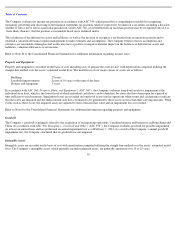American Eagle Outfitters 2013 Annual Report Download - page 21
Download and view the complete annual report
Please find page 21 of the 2013 American Eagle Outfitters annual report below. You can navigate through the pages in the report by either clicking on the pages listed below, or by using the keyword search tool below to find specific information within the annual report.
Table of Contents
Our management considers comparable sales to be an important indicator of our current performance. Comparable sales results are important to
achieve leveraging of our costs, including store payroll, store supplies, rent, etc. Comparable sales also have a direct impact on our total net
revenue, cash and working capital.
Gross profit —Gross profit measures whether we are optimizing the price and inventory levels of our merchandise and achieving an optimal
level of sales. Gross profit is the difference between total net revenue and cost of sales. Cost of sales consists of: merchandise costs, including
design, sourcing, importing and inbound freight costs, as well as markdowns, shrinkage, certain promotional costs and buying, occupancy and
warehousing costs. Design costs consist of: compensation, rent, depreciation, travel, supplies and samples. Buying, occupancy and warehousing
costs consist of: compensation, employee benefit expenses and travel for our buyers and certain senior merchandising executives; rent and
utilities related to our stores, corporate headquarters, distribution centers and other office space; freight from our distribution centers to the
stores; compensation and supplies for our distribution centers, including purchasing, receiving and inspection costs; and shipping and handling
costs related to our e-
commerce operation. The inability to obtain acceptable levels of sales, initial markups or any significant increase in our use
of markdowns could have an adverse effect on our gross profit and results of operations.
Operating income —Our management views operating income as a key indicator of our success. The key drivers of operating income are
comparable sales, gross profit, our ability to control selling, general and administrative expenses, and our level of capital expenditures.
Management also uses earnings before interest and taxes as an indicator of successful operating results.
Return on invested capital—Our management uses return on invested capital as a key measure to assess our efficiency at allocating capital to
profitable investments. This measure is critical in determining which strategic alternatives to pursue.
Store productivity —Store productivity, including total net revenue per average square foot, sales per productive hour, average unit retail price
(“AUR”), conversion rate, the number of transactions per store, the number of units sold per store and the number of units per transaction, is
evaluated by our management in assessing our operational performance.
Inventory turnover
—Our management evaluates inventory turnover as a measure of how productively inventory is bought and sold. Inventory
turnover is important as it can signal slow moving inventory. This can be critical in determining the need to take markdowns on merchandise.
Cash flow and liquidity —Our management evaluates cash flow from operations, investing and financing in determining the sufficiency of our
cash position. Cash flow from operations has historically been sufficient to cover our uses of cash. Our management believes that cash flow from
operations will be sufficient to fund anticipated capital expenditures and working capital requirements.
Our management’s goals are to drive improvements to our gross profit performance, bring greater consistency to our results and to deliver
profitable growth over the long term.
Results of Operations
Overview
Our first quarter results were consistent with our expectations and reflected weak sales, increased markdowns and expense deleverage. Weakness
in demand led to soft traffic and a 5% total net revenue decline. This, combined with elevated inventory levels, negatively impacted gross
margin.
Our first quarter total net revenue decreased 5% to $646.1 million and consolidated comparable sales, including AEO Direct, decreased 10%,
compared to a 5% decrease last year. By brand, American Eagle Outfitters brand comparable sales decreased 11% and aerie brand decreased 4%.
Gross profit decreased 14% to $225.8 million compared to $263.6 million last year and declined 390 basis points to 34.9% as a rate to total net
revenue. The decline is the result of deleverage of rent on negative comparable sales and increased markdowns, partially offset by favorability in
merchandise and design costs.
20
• Shopping behavior has continued to evolve across multiple channels that work in tandem to meet all customer needs. Management
believes that presenting a brand level performance metric that includes all channels (i.e., stores and AEO Direct) to be the most
appropriate, given customer behavior.
• The Company no longer presents AEO Direct separately due to the continued evolution of omni-
channel engagement and the reasons
discussed above.
























